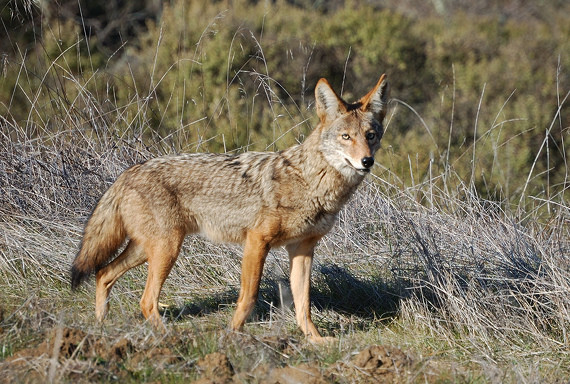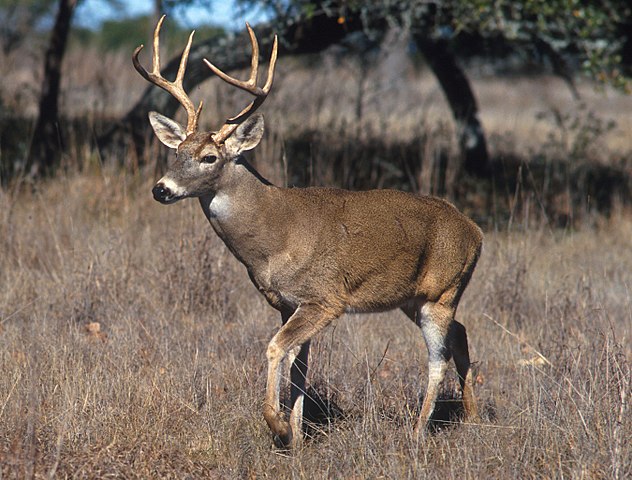Post by dinosauria101 on Jun 18, 2019 15:51:06 GMT 5
Coyote - Canis latrans
The coyote (Canis latrans), also known as the American jackal or the prairie wolf, is a species of canine found throughout North and Central America, ranging from Panama in the south, north through Mexico, the United States and Canada. It occurs as far north as Alaska and all but the northernmost portions of Canada. The color of the coyote's pelt varies from grayish-brown to yellowish-gray on the upper parts, while the throat and belly tend to have a buff or white color. The forelegs, sides of the head, muzzle and paws are reddish-brown. The back has tawny-colored underfur and long, black-tipped guard hairs that form a black dorsal stripe and a dark cross on the shoulder area. The black-tipped tail has a scent gland located on its dorsal base. Coyotes shed once a year, beginning in May with light hair loss, ending in July after heavy shedding. The ears are proportionately large in relation to the head, while the feet are relatively small in relation to the rest of the body. Certain experts have noted the shape of a domestic dog's brain case is closer to the coyote's in shape than that of a wolf's. Mountain-dwelling coyotes tend to be dark-furred, while desert coyotes tend to be more light brown in color. Coyotes typically grow to 30–34 in (76–86 cm) in length, not counting a tail of 12–16 in (30–41 cm), stand about 23–26 in (58–66 cm) at the shoulder and, on average, weigh from 15–46 lb (6.8–21 kg). Northern coyotes are typically larger than southern subspecies, with the largest coyotes on record weighing 74.75 pounds (33.91 kg) and measuring 1.75 m (5.7 ft) in total length.

White-tailed Deer - Odocoileus virginianus
The white-tailed deer (Odocoileus virginianus), also known as the Virginia deer or simply as the whitetail, is a medium-sized deer native to the United States (all but five of the states), Canada, Mexico, Central America, and South America as far south as Peru. The white-tailed deer is highly variable in size, generally following Bergmann's rule that the average size is larger further away from the Equator. North American male deer (also known as a buck or stag) usually weighs 60 to 130 kg (130 to 290 lb) but, in rare cases, bucks in excess of 159 kg (350 lb) have been recorded. In 1926, Carl J. Lenander, Jr. took a white-tailed buck near Tofte, MN, that weighed 183 kg (400 lb) after it was field-dressed (internal organs removed) and was estimated at 232 kg (510 lb) when alive. The female (doe) in North America usually weighs from 40 to 90 kg (88 to 200 lb). White-tailed deer from the tropics and the Florida Keys are markedly smaller-bodied than temperate populations, averaging 35 to 50 kg (77 to 110 lb), with an occasional adult female as small as 25.5 kg (56 lb). White-tailed deer from the Andes are larger than other tropical deer of this species and have thick, slightly woolly-looking fur. Length ranges from 95 to 220 cm (37 to 87 in), including a tail of 10 to 36.5 cm (3.9 to 14.4 in), and the shoulder height is 53 to 120 cm (21 to 47 in). Including all races, the average summer weight of adult males is 68 kg (150 lb) and is 45.3 kg (100 lb) in adult females.

Credit to Wikipedia
The coyote (Canis latrans), also known as the American jackal or the prairie wolf, is a species of canine found throughout North and Central America, ranging from Panama in the south, north through Mexico, the United States and Canada. It occurs as far north as Alaska and all but the northernmost portions of Canada. The color of the coyote's pelt varies from grayish-brown to yellowish-gray on the upper parts, while the throat and belly tend to have a buff or white color. The forelegs, sides of the head, muzzle and paws are reddish-brown. The back has tawny-colored underfur and long, black-tipped guard hairs that form a black dorsal stripe and a dark cross on the shoulder area. The black-tipped tail has a scent gland located on its dorsal base. Coyotes shed once a year, beginning in May with light hair loss, ending in July after heavy shedding. The ears are proportionately large in relation to the head, while the feet are relatively small in relation to the rest of the body. Certain experts have noted the shape of a domestic dog's brain case is closer to the coyote's in shape than that of a wolf's. Mountain-dwelling coyotes tend to be dark-furred, while desert coyotes tend to be more light brown in color. Coyotes typically grow to 30–34 in (76–86 cm) in length, not counting a tail of 12–16 in (30–41 cm), stand about 23–26 in (58–66 cm) at the shoulder and, on average, weigh from 15–46 lb (6.8–21 kg). Northern coyotes are typically larger than southern subspecies, with the largest coyotes on record weighing 74.75 pounds (33.91 kg) and measuring 1.75 m (5.7 ft) in total length.

White-tailed Deer - Odocoileus virginianus
The white-tailed deer (Odocoileus virginianus), also known as the Virginia deer or simply as the whitetail, is a medium-sized deer native to the United States (all but five of the states), Canada, Mexico, Central America, and South America as far south as Peru. The white-tailed deer is highly variable in size, generally following Bergmann's rule that the average size is larger further away from the Equator. North American male deer (also known as a buck or stag) usually weighs 60 to 130 kg (130 to 290 lb) but, in rare cases, bucks in excess of 159 kg (350 lb) have been recorded. In 1926, Carl J. Lenander, Jr. took a white-tailed buck near Tofte, MN, that weighed 183 kg (400 lb) after it was field-dressed (internal organs removed) and was estimated at 232 kg (510 lb) when alive. The female (doe) in North America usually weighs from 40 to 90 kg (88 to 200 lb). White-tailed deer from the tropics and the Florida Keys are markedly smaller-bodied than temperate populations, averaging 35 to 50 kg (77 to 110 lb), with an occasional adult female as small as 25.5 kg (56 lb). White-tailed deer from the Andes are larger than other tropical deer of this species and have thick, slightly woolly-looking fur. Length ranges from 95 to 220 cm (37 to 87 in), including a tail of 10 to 36.5 cm (3.9 to 14.4 in), and the shoulder height is 53 to 120 cm (21 to 47 in). Including all races, the average summer weight of adult males is 68 kg (150 lb) and is 45.3 kg (100 lb) in adult females.

Credit to Wikipedia




